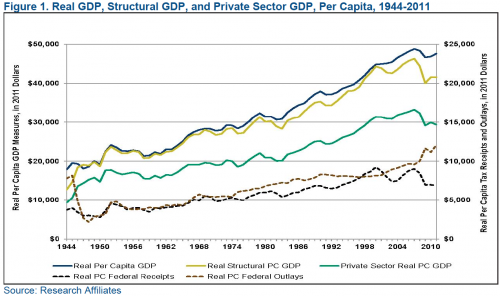Does Unreal GDP Drive Our Policy Choices?
by Robert Arnott, Research Affiliates LLC
Gross Domestic Product is used to measure a country’s economic growth and standard of living. It measures neither. Unfortunately, the finance community and global centers of power are wedded to a measure that bears little relation to reality, because it confuses prosperity with debt-fueled spending.
Washington is paralyzed by fears that any withdrawal of stimulus, whether fiscal or monetary, whether by the Administration, the Fed, or the Congress, may clobber our GDP. And they’re right. But, GDP is the wrong measure.
Without an alternative, we will continue to make bad policy choices based on bad data. Eventually, our current choices may wreak havoc with our future prosperity, the future purchasing power of the dollar, and the real value of U.S. stocks and bonds.
What is GDP?
GDP is consumer spending, plus government outlays, plus gross investments, plus exports minus imports. With the exception of exports, GDP measures spending. The problem is GDP makes no distinction between debt-financed spending and spending that we can cover out of current income.
Consumption is not prosperity. The credit-addicted family measures its success by how much it is able to spend, applauding any new source of credit, regardless of the family income or ability to repay. The credit-addicted family enjoys a rising “family GDP”—consumption—as long as they can find new lenders, and suffers a family “recession” when they prudently cut up their credit cards.
In much the same way, the current definition of GDP causes us to ignore the fact that we are mortgaging our future to feed current consumption. Worse, like the credit- addicted family, we can consciously game our GDP and GDP growth rates—our consumption and consumption growth—at any levels our creditors will permit!
Consider a simple thought experiment. Let’s suppose the government wants to dazzle us with 5% growth next quarter (equivalent to 20% annualized growth!). If they borrow an additional 5% of GDP in new additional debt and spend it immediately, this magnificent GDP growth is achieved! We would all see it as phony growth, sabotaging our national balance sheet—right? Maybe not. We are already borrowing and spending 2% to 3% each quarter, equivalent to 10% to 12% of GDP, and yet few observers have decried this as artificial GDP growth because we’re not accustomed to looking at the underlying GDP before deficit spending!
From this perspective, real GDP seems unreal, at best. GDP that stems from new debt—mainly deficit spending—is phony: it is debt-financed consumption, not prosperity. Isn’t GDP, after excluding net new debt obligations, a more relevant measure? Deficit spending is supposed to trigger growth in the remainder of the economy, net of deficit-financed spending, which we can call our “Structural GDP.” If Structural GDP fails to grow as a consequence of our deficits, then deficit spending has failed in its sole and singular purpose.1
Of course, even Structural GDP offers a misleading picture. Our Structural GDP has grown nearly 100-fold in the last 70 years. Most of that growth is due to inflation and population growth; a truer measure of the prosperity of the average citizen must adjust for these effects. Accordingly, let’s compare real per capita GDP with real per capita Structural GDP.
A New Measure of Prosperity
Real per capita GDP has recovered to within 2.5% of the 2007 peak of $48,000 (in 2010 dollars). So, why do we feel so bad? For one thing, after two recessions, we’re up barely 6% in a decade. Furthermore, this scant growth is entirely debt-financed consumption. The real per capita Structural GDP, after subtracting the growth in public debt, remains 10% below the 2007 peak, and is down 5% in the past decade. Net of deficit spending, our prosperity is nearly unchanged from 1998, 13 years ago.
As a diagnostic for why this has happened, let’s go one step further. Few would argue that a healthy economy can grow without the private sector leading the way. The real per capita “Private Sector GDP” is another powerful measure that is easy to calculate. It nets out government spending—federal, state, and local. Very like our Structural GDP, Private Sector GDP is bottom-bouncing, 11% below the 2007 peak, 6% below the 2000–2003 plateau, and has reverted to roughly match 1998 levels.
Figure 1 illustrates the situation. Absent debt-financed consumption, we have gone nowhere since the late 1990s.
Source: Research Affiliates As the private sector has crumbled, and Structural GDP has lost 13 years of growth, tax receipts have collapsed. Real per capita federal tax receipts have tumbled to levels first achieved in 1994, and are fully 25% below the peak levels of 2000.2 The 2000 peak in tax receipts was, of course, bolstered by unprecedented capital gains tax receipts following the wonder years of the 1990s. But this surge in tax receipts fueled a perception—even in a Republican-dominated government!—that there was money to burn, as if the capital gains from the biggest bull market in U.S. stock market history would continue indefinitely!













Comments are closed.